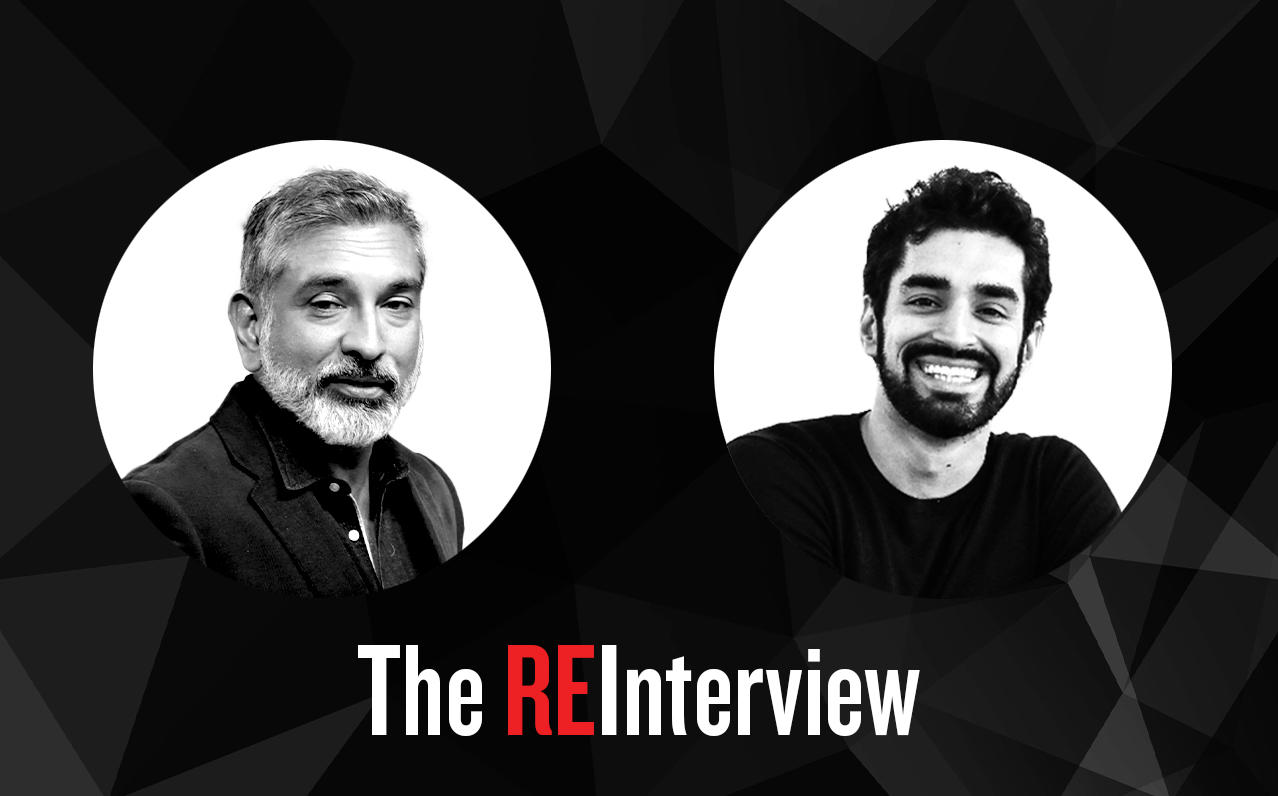
Land prices in Manhattan are among the highest in the world, and developers have become adept at extracting every possible square foot of value in a supply-choked market. But according to one prominent architect, there’s a lot more land to be had – and a more equitable and interesting New York to be enjoyed – if Manhattan were to say “no mas!” to one interloper: private cars.
Vishaan Chakrabarti, founder of Practice for Architecture and Urbanism and the new dean of the UC Berkeley College of Environmental Design, recently collaborated with the New York Times’ Farhad Manjoo on a feature looking at a Manhattan without private cars. The article examined PAU’s vision of freeing up more than 3,000 acres currently devoted to them, and what it would mean for public transit, the environment, housing and the city’s overall look, feel and quality of life.
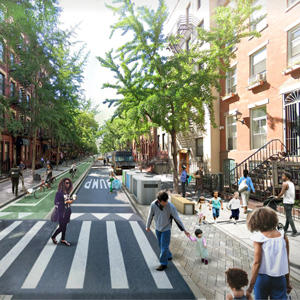
If parking were removed and private cars banned from West 45th Street (Credit: PAU)
The article was the talk of the town, but Chakrabarti told The Real Deal that the response from the real estate industry was “crickets.” TRD caught up with him to get more details on the development aspects of the plan, such as its potential impact on land prices, the kind of housing that could be built, and how it could usher in a very different real estate market.
This interview has been condensed and edited for clarity.
People have imagined a more pedestrian-friendly New York, a more mindful New York, a New York that is more equitable across race and socioeconomic class. But they’ve proposed incremental changes. Your plan is radical; you’re saying, “Let’s start from scratch.” Did you do that in your spare time?
I think the New York Times pays its op-ed contributors $150, so we might get a check to buy a couple of margaritas for my staff when we get back. But no, we do the occasional project where it’s a social advocacy project for us.
When you say it’s radical… Look at the Park Avenue image in our presentation. The original design for Park Avenue that Cornelius Vanderbilt put forward had a park in the middle. Over time, especially in the ’50s when we were in the postwar boom era for cars, we took away the park and turned it into this useless median. And so all we’re proposing, radically, is to go back to the original design, which I would remind everyone is what created one of the most valuable areas for real estate in the world.
I think we have to remind ourselves of the genesis of the value of New York. It was not about cars interacting with other cars. It was about people interacting with people. That is sort of the magic sauce of New York City. Now, of course, everyone’s going to say, well, congestion, Covid…
We’re going to talk about that a bit.
But walking and biking in our city has proven to be actually a great response to Covid, as long as you’ve got the ample sidewalk space, bike space and so forth. And that’s where, again, you want to eliminate the private car, so that you have more room for these other uses.
What rich people need to start doing is thinking about people, other than just other rich people.
“Land, they don’t build any more of it,” is the old chestnut, but there’s plenty to go around in your plan. Have you thought a little bit about what that would do to land values?
Thirty percent of Manhattan is road bed. So we need to think about how to more effectively use that. The CEOs of real estate companies are going to say, “Oh my gosh, all of those tenants that drive their private cars in from New Jersey or Westchester who are senior managers, this is going to be another hit to my bottom line,” in a world where Covid is already representing a kind of existential threat to the New York office market because of remote work and so forth.
I think they need to think about it exactly the opposite way. Because if you think about the CEO of a major company who’s making the decision to locate his or her office space in an office building, the first thing they think about is, “How are my employees going to get here?”
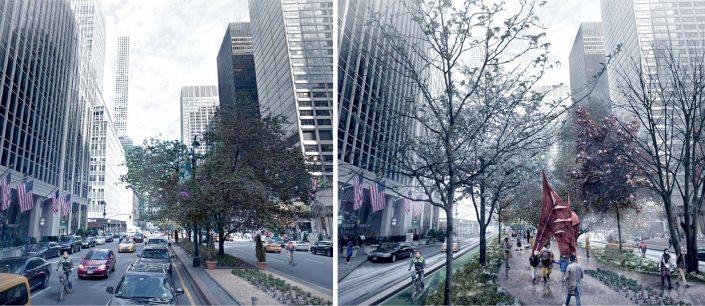
A redesigned Park Avenue could expand the median into a wide pedestrian promenade (Credit: PAU)
“Location, location, location,” that’s the other chestnut. We tried to say that this proposal wasn’t just about Manhattan, but the fact is that when you reduce private cars or eliminate private cars in Manhattan, what you do is really eliminate the demand of all of that traffic regionally. So think about, for example, your average middle manager who lives in Montclair, New Jersey, or Staten Island, and takes an express bus into New York City every day. Their commute times drop by almost half when you do this. So the thing is, for the regional workforce, it makes New York City way more attractive.
What rich people need to start doing is thinking about people, other than just other rich people. That’s the problem. They just think through the lens of their own bubble, of their own black car. So when you’ve got Twitter saying that their whole workforce can work remotely forever, the people who’ve been doing this in places like New York City, who think that they can just apply the same old formula again and again and again, and think that in a post-Covid environment that’s going to work, they have to wake up. People are tired of places like Penn Station. Just all these things we call transit-oriented development are relying on transit that was built 100 years ago. They have to stop doing that. Stop thinking about it just through the lens of their own kind of country club set, and think about it through the lens of the worker.
Once the spell has been broken by this prolonged working from home, it’s going to be a lot harder, no matter what landlords do, to bring people back to the office. In this plan, is there any accommodation for these hulking office complexes that probably are not going to see full occupancy for years to come or need to be repositioned or reimagined?
I worked for the Bloomberg administration after 9/11, and we upzoned a lot of Manhattan, including Hudson Yards. I was very much in favor of the Midtown East rezoning and One Vanderbilt and all of that stuff. It’s terrific. We need that new office space. And I think that the newer office space that has newer ventilation systems, has outdoor terraces and so forth, that stuff should do pretty well in the rebound. What you have to worry about is the stuff in the middle.
That Garment District building with HVAC from the 1800s or something.
Although the ones with operable windows, again, are going to be in better shape. I worry about the stuff along Sixth Avenue. In some cases, we’re going to have a huge housing crisis that stems not from gentrification, but from homelessness and poverty. And in some cases, I’m hoping we’re going to see the conversion of older office stock into residential.
So, say a vaccine comes out next month. The genie you can’t put back in the bottle is this remote work thing. My office is staying in New York City. We’re all going to run back to the office as soon as it’s safe, because we want to interact with each other, we’re in a creative industry, we want to be together. You also have to understand that a huge amount of New York’s workforce — the paralegal, the person who’s filling out insurance forms — a lot of those folks work in a cubicle, don’t need to interact with their colleagues as much. They commute through horrible places like Penn Station, they have really dreadful commutes. That person’s going to say to their CEO, “Look, here’s the deal I’ll make with you. I want to work from home. I’ll stay in the region and commute in once every two weeks for a meeting or an event or something.”
I don’t even think they’ll need to have that conversation. I think the economics of it will make that happen. Your whole plan and the reason I’m so drawn to it is that it says, “Stop bubble-fying yourself.” It’s a much more equitable plan, or at least it hopes to be. But in a post-Covid world, do you not feel like the psychology is going to be even more stratification, even more bubbling?
We’re going to have a massive, massive homeless and poverty crisis in this country that is going to remind us of the 1930s. And we’re going to need a government response that’s commensurate.
I hope not. The answer can’t be, though, that everyone — that 8.6 million New Yorkers, 3.5 million people who come in and out of Manhattan every day — are going to somehow drive in their own car because they don’t want to be on public transit because they don’t want to risk it. So how do you then address this problem, if that is the psychology? What we’re trying to say is, “let’s use the space.” In our plan, you can run way more buses. Our mass transit is so congested because private cars are hogging up all the space. I was never a bus rider because buses are always so slow in New York City. And I live and work near 14th Street. And when [the ban of private cars on] 14th Street happened, I was like, “Holy shit. I can get across 14th Street in six minutes on a bus.” I have my cellular connection the entire time. I can open a window. And it’s just easier to hop on, hop off. And so buses suddenly become wildly attractive for everyday people because they move quickly.
One of the things that has always been a conundrum is, “Hey, the land is too expensive for me to build anything but luxury condos.” And the buildings that were built were not solving the affordable housing issue, not creating a more equitable Manhattan. The reason is land prices kept going up. Banks would only finance something if you could sell condos at $1,200, $1,400 a square foot. You’re talking about four Central Parks’ worth of additional land with this plan. What sort of housing do you hope would be built?
When I ran the real estate program at Columbia, my first question to the incoming class would be: “Walk around New York City. Why is there a single surface parking lot in one of the most valuable land masses in the world?” Well, if you’re in real estate, you know the answer, which is, someone’s got a low basis on that land, and the net operating income they get from parking is risk-free. And they have therefore the incentive to keep it parking as opposed to building, and the tax basis is really low.
What am I doing? I’m taking away their market by taking away the private car. So now that landowner has an outsized incentive to redevelop that property. I’m really hoping that under a President Biden, we’re going to see a national housing agenda where the federal government gets involved, as they have historically since the 1930s…and creates new incentives to create housing. I don’t think people realize the world of hurt out there, and that’s only going to expand.
We’re seeing some rumblings now, but the real pain is already being felt at street level.
Right. And my point is we’re going to have a massive, massive homeless and poverty crisis in this country that is going to remind us of the 1930s. And we’re going to need a government response that’s commensurate. We’re going to need that level of intervention, coupled with the fact that all of a sudden, you’re going to have this land. So that formula, that I know very well, where a developer can only build luxury condos…
And you’ve worked for a lot of those developers. I’m trying to understand how their thinking changes from, “All right, let’s build the least housing we can for the wealthiest people and replicate that formula over and over.”
There won’t be the market for the luxury condos. Who’s going to buy them? We had a glut of luxury condos in New York City pre-Covid. How deep does the real estate industry think the market is for $6 million apartments? We’ve got to get real. This entire discipline has to focus on the needs of everyday people.
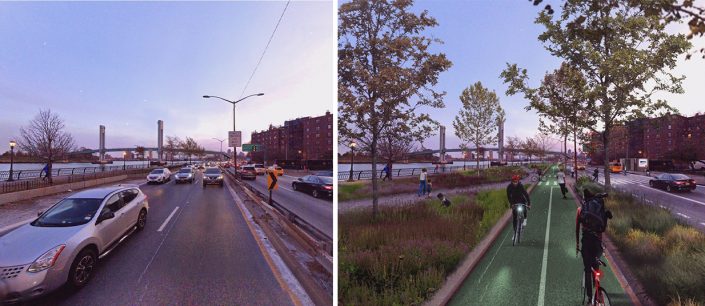
PAU proposes connecting the greenway along FDR Drive to the greenway on the West Side, creating a path around the island’s perimeter. (Credit: PAU)
I understand that developers, often when they’re looking at a pro forma, nothing works, like you said, because the underlying land cost is so high. So one of the things our proposal would do is create much more available land because it’s not available for surface parking. That’s going to bring down land prices. We also have to change our tax regime because there’s too much of an incentive for people to land-bank right now.
The government has to do a variety of things to basically make the housing market more liquid and more affordable. We also need to look at things like tall timber construction and the ability to change our materials to make construction cheaper.
Do you think timber could actually take hold? You had that 18-story project that didn’t quite make it.
The challenge here is the concrete industry sees this as an existential threat. Concrete is about the worst thing you can imagine for the environment. It’s interesting. During the Covid shutdown, we have not seen the carbon emissions drop that you would imagine. And that’s because concrete and steel plants are still going, based on the real estate pipeline.
And so we’ve got to be building out of different materials that are better for the environment, that are cheaper to build. But the government has to step in and do a bunch of things in terms of taxes, in terms of regulatory reform.
You’re talking government at every level?
I’m talking at the federal level, there needs to be investment, at the state and city level, in terms of regulation and creating new programs. Cities have survived pandemics, cities have survived terrorist attacks. But remember, after 9/11, New York City received $20 billion of government aid. We’re not going to just recover on our own. This is a huge crisis for cities.
You put this plan out there. You had been probably finalizing it as we were in full shutdown, and people could viscerally grasp the benefits of this private car-free Manhattan. Unfortunately, that seems like a distant memory now. Traffic’s back. I’m in L.A. at the moment; I drove out yesterday and it looked like the freeway from hell, as usual. Do you think we’ve already missed our shot in getting these sort of things in place?
That’s why we did the article, as a provocation. I am very much hoping that this becomes a topic in the mayoral election. It should be a topic of the next gubernatorial debate. And it just needs to be thought about broadly. I think what’s interesting is this came out a week before I was moving to California and all sorts of people contacted me about whether this is going to be possible in San Francisco.
Did you get any real estate industry reaction?
Crickets.
This blew up. There’s no way that they did not see this.
Absolutely. But again, building in New York is hard. I’m not a development basher by any stretch of the imagination. But at the same time, I really think that people have to look beyond their windshield. What I find in the New York development community — not everyone, but too many people – are just too focused in their own reality, as opposed to the fact that real estate in New York, as an industry, is serving a city of 8.6 million people. And the vast majority of them don’t own cars. There’s only about a million car owners in New York City. Most of these people move around in mass transit. It’s part of why they moved to New York City. So they’ve got to think about their market.
In their minds, their perception has always been, “I’m a developer/civic champion of New York.” That’s the way a lot of big developers think about themselves.
There’s really a tradition of that. If you think about the recovery after the 1970s [fiscal crisis], that’s absolutely been true.
In the 1970s, they prepaid their property taxes. That’s one of the big things that people always bring up. This time, we didn’t really see much in terms of stepping up as an industry collectively.
Right after 9/11, people thought, “Oh my God, I don’t want to even build a Quonset hut in New York City again.” Government policy is an ax, not a scalpel. It doesn’t work in very precise ways. And so we loosened up all the spigots. We upzoned, all sorts of incentives were created for development. At the same time, quantitative easing was going on at the federal level. By 2005, you had this huge rush into condo development in a city that largely only built rentals.
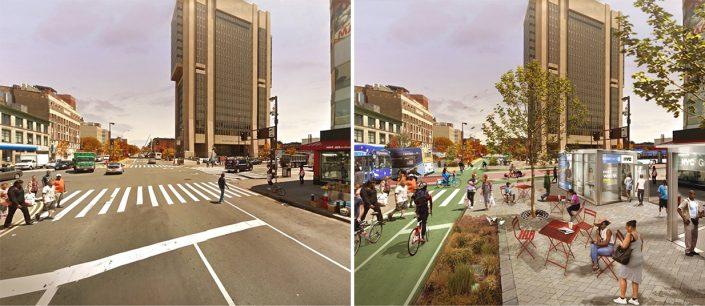
Before and after pedestrianizing Adam Clayton Powell Jr. Boulevard at 125th Street (Credit: PAU)
And so this thing about gentrification and the real estate industry, a lot of that was inadvertent. It’s just very hard, once you loosen the reins, to constrain it again. So all of a sudden, we had this city that not just recovered, but became this ultra, ultra wealthy city. And you had crime going down. And then all of a sudden, you saw in Manhattan, from 2000 to 2010, the number of children under the age of five go up by 40 percent, which meant that all the people who used to suburbanize were suddenly buying five-bedroom condominiums in Manhattan. And so the entire gestalt of the city changes.
The whole industry changed because of those dynamics. And now we’ve got another crisis that is asking us to change again and not just try to go back to the model that has existed since 9/11, but actually say, “No, this next model has to be about affordability, and it has to be about equity.” I think we should start with our streets.
Write to Hiten Samtani at hs@therealdeal.com. To check out more of The REInterview, a series of in-depth conversations with real estate leaders and newsmakers hosted by Samtani, click here.
